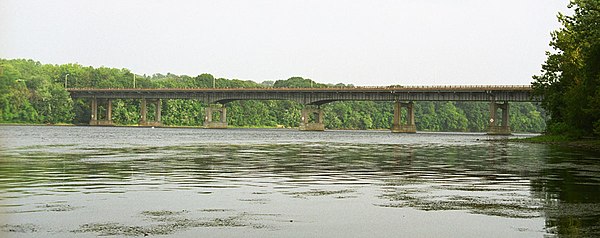The Connecticut Portal

Connecticut (/kəˈnɛtɪkət/ kə-NET-ik-ət) is the southernmost state in the New England region of the Northeastern United States. It borders Rhode Island to the east, Massachusetts to the north, New York to the west, and Long Island Sound to the south. Its capital is Hartford, and its most populous city is Bridgeport. Connecticut lies between the major hubs of New York City and Boston along the Northeast Corridor, where the New York metropolitan area, which includes six of Connecticut's seven largest cities, extends well into the southwestern part of the state. Connecticut is the third-smallest state by area after Rhode Island and Delaware, and the 29th most populous with slightly more than 3.6 million residents as of 2020, ranking it fourth among the most densely populated U.S. states.
The state is named after the Connecticut River, the longest in New England which roughly bisects the state and drains into the Long Island Sound between the towns of Old Saybrook and Old Lyme. The name of the river is in turn derived from anglicized spellings of Quinnetuket, a Mohegan-Pequot word for "long tidal river". Before the arrival of the first European settlers, the region was inhabited by various Algonquian tribes. In 1633, the Dutch West India Company established a small, short-lived settlement called House of Hope in Hartford. Half of Connecticut was initially claimed by the Dutch colony New Netherland, which included much of the land between the Connecticut and Delaware Rivers, although the first major settlements were established by the English around the same time. Thomas Hooker led a band of followers from the Massachusetts Bay Colony to form the Connecticut Colony, while other settlers from Massachusetts founded the Saybrook Colony and the New Haven Colony; both merged into the former by 1664.
Connecticut's official nickname, the "Constitution State", refers to the Fundamental Orders adopted by the Connecticut Colony in 1639, which is considered by some to be the first written constitution in Western history. As one of the Thirteen Colonies that rejected British rule during the American Revolution, Connecticut was influential in the development of the federal government of the United States. In 1787, Roger Sherman and Oliver Ellsworth, state delegates to the Constitutional Convention, proposed a compromise between the Virginia and New Jersey Plans; its bicameral structure for Congress, with a respectively proportional and equal representation of the states in the House of Representatives and Senate, was adopted and remains to this day. In January 1788, Connecticut became the fifth state to ratify the Constitution. (Full article...)

General images -
Selected picture -

State facts
- Nicknames: The Provisions State, The Land of Steady Habits, The Constitution State, The Nutmeg State
- Capital: Hartford
- Governor: Ned Lamont (D)
- Lieutenant Governor: Susan Bysiewicz (D)
- Secretary of State: Stephanie Thomas (D)
- Attorney General: William Tong (D)
- Senators: Chris Murphy (D), Richard Blumenthal (D)
- Representatives: Jahana Hayes (D), Jim Himes (D), Joe Courtney (D), John B. Larson (D), Rosa DeLauro (D)
- Total area: 5,543 mi2
- Land: 4,845 mi2
- Water: 698 mi2
- Highest elevation: 2,379 ft (Mount Frissell)
- Population 3,576,452 (2015 est)
- Admission to the Union: January 9, 1788 (5th)
State symbols:
- Animal: Sperm whale
- Bird: American Robin
- Fish: American Shad
- Flower: Mountain Laurel
- Fossil: Dinosaur Track
- Insect: European Praying Mantis
- Ship: USS Nautilus (SSN-571)
- Songs: Yankee Doodle
- Tree: Charter Oak
- Mineral: Almandine
Selected article -

Oliver Ellsworth (April 29, 1745 – November 26, 1807) was a Founding Father of the United States, attorney, jurist, politician, and diplomat. Ellsworth was a framer of the United States Constitution, United States senator from Connecticut, and the third chief justice of the United States. Additionally, he received 11 electoral votes in the 1796 presidential election.
Born in Windsor, Connecticut, Ellsworth attended the College of New Jersey where he helped found the American Whig–Cliosophic Society. In 1777, he became the state attorney for Hartford County, Connecticut, and was selected as a delegate to the Continental Congress, serving during the remainder of the American Revolutionary War. He served as a state judge during the 1780s and was selected as a delegate to the 1787 Philadelphia Convention, which produced the United States Constitution. While at the convention, Ellsworth played a role in fashioning the Connecticut Compromise between the more populous states and the less populous states. He also served on the Committee of Detail, which prepared the first draft of the Constitution, but he left the convention and did not sign the document. (Full article...)Did you know? -
- ... that a Connecticut radio station left the FM band for good after it was out of service for a week and only one person wrote a letter to complain?
- ... that the Meriden, Waterbury and Connecticut River Railroad, created as an alternative to the New Haven Railroad, was absorbed into the New Haven after just 11 years?
- ... that after her father received hospice care, Connecticut state legislator Claudia Powers introduced bills to include hospice under Medicare?
- ... that Darien, Connecticut, was once home to a train station built inside a cemetery?
- ... that a Connecticut radio station was "the loser in a survival-of-the-fittest battle"?
- ... that in 2023, Ralph Nader founded the newspaper Winsted Citizen in his hometown of Winsted, Connecticut, where he delivered papers as a boy?
In the news

- February 10: Disney to shut down Blue Sky Studios, animation studio behind 'Ice Age'
- October 17: Hundreds arrested for 'dark web' child porn by international task force
- October 3: World War II era plane crashes in Connecticut, US, killing at least seven
- February 21: Sixteen states sue U.S. President Trump to stop declaration of emergency for border wall
Categories
Related WikiProjects

WikiProject Connecticut • WikiProject Connecticut routes • WikiProject UCONN
Selected panorama
Topics
Related portals
Associated Wikimedia
The following Wikimedia Foundation sister projects provide more on this subject:
-
 Commons
Commons
Free media repository -
 Wikibooks
Wikibooks
Free textbooks and manuals -
 Wikidata
Wikidata
Free knowledge base -
 Wikinews
Wikinews
Free-content news -
 Wikiquote
Wikiquote
Collection of quotations -
 Wikisource
Wikisource
Free-content library -
 Wikiversity
Wikiversity
Free learning tools -
 Wikivoyage
Wikivoyage
Free travel guide -
 Wiktionary
Wiktionary
Dictionary and thesaurus

















































Recent Comments